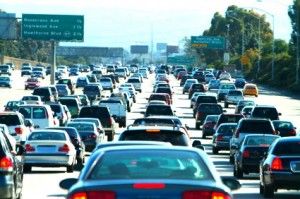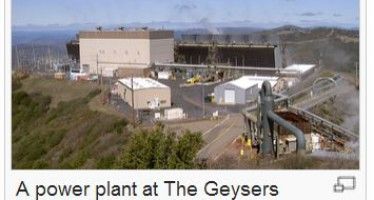California needs $765 billion in new roads
By Dave Roberts
California’s infrastructure — once the envy of the nation in the 1950s and 60s — has not kept up with growth and has been allowed to deteriorate. Out of $142 billion in total state funding in the current budget, only 5 percent ($7.6 billion) goes to the Department of Transportation.
Decades of neglect have resulted in a $765 billion infrastructure funding shortfall over 10 years in California, according to a report by the Nicholas Berggruen Institute.
“California faces a mammoth infrastructure challenge — from building a smart energy grid to relieving traffic congestion, refurbishing ports and expanding the broadband information highways of the future,” the report states.
Roads and transit alone require $538 billion over 10 years, according to a California Transportation Commission report; $341 billion of it is needed just for ongoing maintenance and rehabilitation. Available revenue covers only 45 percent of the total, leaving a $296 billion shortfall.
“Today, California’s transportation system is in jeopardy,” the CTC report states. “Investments to preserve transportation systems simply have not kept pace with the demands on them, and this underfunding — decade after decade — has led to the decay of one of the state’s greatest assets. Failing to adequately invest in the restoration of California’s roads, highways, bridges, airports, seaports, railways, border crossings and public transit infrastructure will lead to further decay and a deterioration of service from which it may take many years to recover.”
But rather than dole out more revenue to infrastructure, state and local officials are looking to taxpayers to pick up the tab. Increases in gas taxes, sales taxes, the vehicle license fee, tolls, bond measures, congestion pricing and other “revenue opportunities” are likely to be on the table in the coming years.
The Little Hoover Commission, a state watchdog agency, released a report two years ago on the infrastructure crisis. It recommended creating more state and local public-private partnerships to finance, design, build and operate infrastructure projects when doing so would increase efficiency, reduce costs and speeddelivery.
“The decisions California’s leaders make now in how the state invests in its infrastructure can help California and its people recover from the worst recession since the Great Depression and lay a foundation for a competitive, world-class economy for decades to come,” the commission report states. “The way California currently spends its infrastructure dollars lacks a long-term vision and a systematic process for prioritizing projects. … California’s pattern of borrowing money through general obligation bonds and repaying debt through the General Fund to pay for infrastructure investments will force further spending cuts in healthcare, social services, education and public safety programs.”
Little change
Nearly two years later, little has changed. And that frustrated Little Hoover Commissioner David Schwarz, speaking at a September commission hearing on infrastructure and pensions.
“We, it seems to me, have gone backwards in terms of thinking creatively about alternative ways to finance infrastructure projects,” he said. “We did a significant study on this in 2010. We had some very specific recommendations. Those have not been followed. So, if you sense some frustration in my voice, it’s only because it strikes me that we are avoiding innovation and going backwards.”
About 30 percent of California’s infrastructure projects might lend themselves to public-private partnerships, potentially saving the state $230 billion over 10 years, according to Sean Randolph, president and chief executive officer of the Bay Area Council Economic Institute.
“We all take some pride in California as the world’s most innovative place, where trends begin, we’re first-adopters and they’re adopted later on by other people,” he told the commission. “But when it comes to how we finance and operate infrastructure, that’s definitely not the case.
“Historical experience shows that a public-private partnership methodology will normally save about 15-30 percent for the government over the cost of doing that through traditional government procurement methods. A lot of that comes by the greater speed of delivery. The risk of delivering that infrastructure on time and on budget is shifted to the private sector. A lot of the cost of infrastructure is the cost of run-ups, late delivery, over-budget. Historical experience shows in other places that public-private partnership projects are almost always delivered on time or ahead of schedule, on budget or even below budget.”
Randolph emphasized that public-private partnerships don’t have to be limited to toll roads and bridges. The United Kingdom rebuilt most of its high schools and Canada rebuilt many of its hospitals using public-private partnerships. Instead of collecting a toll, the developers receive annual payments from the government. There have been a few public-private projects in California: the $1.4 billion Presidio Parkway in San Francisco, student housing at UC Merced, a UC San Francisco neuroscience building.
[Correction Dec. 31, 2012: UC Merced did not use a private-public partnership to provide student housing, but is considering it for future campus growth.]
No leadership
But in the past two years no major public-private partnership projects have been launched, and the CTC’s Public Infrastructure Advisory Committee has not met.
“There’s a lot of potential projects, but no significant activity or leadership at the state level since 2010,” said Randolph. “And we feel it’s important that this topic get back on the state agenda and start to be looked at more closely. And that we get some processes in place again that will let us start to build a pipeline of projects that would attract more international capital.”
Market principles are also coming into play with the conversion of HOV lanes to double as toll lanes. I-15 was once the most congested corridor in the San Diego area. At the same time, its HOV lane was under-utilized, according to Gary Gallegos, executive director of the San Diego Association of Governments. After converting the HOV lane to accept Fastpass tolls, I-15 is now the best performing corridor in the area, generating revenue for transportation improvements from its 40,000 daily motorists. The plan is to expand it to a 100-200-mile toll network.
One of the challenges was getting all of the jurisdictions to sign off on the project. The project faced opposition from both left and right.
“The Republicans kind of go libertarian on you on this stuff,” said Gallegos. “It’s kind of like, ‘We may have already paid for that. Is this double taxation if we’re pricing it?’ The Democrats go ‘Lexus Lane’ on you. So you have got to figure out how you build a bridge between the libertarians and the Lexus Lane guys. There’s legitimate philosophical differences. We’ve had to try to bridge those differences.”
One public-private partnership didn’t turn out so well for the private, but the public has benefited. The developer of Highway 125 went bankrupt after the economy tanked and ridership didn’t meet expectations. San Diego bought the road, paying $345 million for a nearly $900 million project. Since taking over operation, the tolls have been reduced 40-50 percent and ridership is up about 60 percent.
Environment
The other major challenge in providing more infrastructure is the California Environmental Quality Act. It’s become the never-ending source for litigation complaints whenever anyone wants to delay or stop a project. A lawsuit has been filed against San Diego’s regional transportation plan, alleging CEQA violations. Joining the usual environmental and social advocacy groups in the petition is Attorney General Kamala Harris. Yes, one branch of California’s government is suing another.
“In these big transportation projects that’s one of the frustrations is you can go through all the process, but at the end of the day you’re still vulnerable to a CEQA challenge,” said Gallegos.
It’s gotten so bad that projects of moderate complexity are taking a decade to get through the environmental process, according to Jim Earp, executive director of the California Alliance for Jobs. He’s hoping to reform that process.
“The question is: Should CEQA be used as it often is used now? And that is really more as a litigation tool and a tool to impede a project than really to enforce or monitor environmental responsibility,” he said. “So what’s been done in recent years is you try to get a CEQA exemption on a stadium or a project or whatever. The underlying assumption of that is that there’s something wrong with CEQA if you have to go and exempt it all the time or here and there to get a project in.
“Why don’t we look at the law and figure out if there’s something structurally you can do to ensure that the original intent of the law is maintained. But prevent the ability of groups or individuals to use it in ways to pursue some other agenda. There’s an attempt underway right now to look at CEQA in that light. It’s gotten some traction. I don’t know which way it’s going to go. There’s not unanimity on it. Obviously, the environmental community doesn’t like it.”
Ultimately the hearing kept coming back to the question: How can California provide more funding for infrastructure? Will Kempton, chief executive officer of the Orange County Transportation Authority and former director of Caltrans, wants the gas tax raised. Californians are paying 68.9 cents/gallon in federal, state and local gas taxes, second highest in the nation, according to the American Petroleum Institute.
“It’s unfortunate that we call it a tax because in effect it’s a user fee,” said Kempton. “It’s one of the best user fees that has existed in modern times in support of a program, as far as I’m concerned. There’s a lot of things we can do with a gas tax. We can certainly expand it. But there are things we can do to make it grow with inflation and indexing that are needed there.”
Earp said he prefers reducing the voting approval threshold for sales tax measures from two-thirds to 55 percent. It’s likely that these measures and others will be voted on in the coming years as the Democrats tighten their vice grip on power in Sacramento.
Related Articles
Greenhut dissects High-Speed Rail boondoggle
April 9, 2012 By John Seiler Writing on Bloomberg, our Contributing Editor Steven Greenhut dissects the latest shenanigans in the
Geothermal mandate could drive up energy costs
California residents and businesses could be paying an extra $400 million annually for electricity if a geothermal energy mandate
AB 32 Poll To Be Released Today
Later today a poll will be released demonstrating that a large majority of Californians want AB 32 suspended. The consequences




